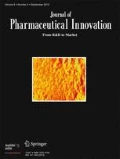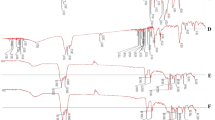Abstract
Purpose
In this study, the preparation of self-assembled polymer-free in situ forming nanovesicles (ISNs) based on non-ionic surfactants (NISs) is presented.
Methods
A 22·41 full factorial experimental design was adopted for the development of novel polymer-free ISNs loaded with tenoxicam utilizing the emulsion method. The type of NIS (Brij® 52 or Span® 60), the cholesterol percentage (30, 50, or 60 w/w%), and the internal phase percentage (20 or 30 v/v%) were chosen as the independent variables. Percentage drug released after 1 h (Q1), vesicle particle size (PS), and mean dissolution time (MDT) were the dependent variables. Selected formulation was investigated morphologically using transmission electron microscopy.
Results
Results revealed that the formation had spherical dense shape. All independent factors significantly affected the percentage drug release after the first hour (Q1), and the MDT, while only the type of NIS had a significant effect on PS. The highest control of drug release was observed in formulation containing Span® 60 with lower internal phase percentage (MDT = 20.06 ± 0.40 h) as well as the smallest PS (123.75 ± 16.68 nm).
Conclusion
The obtained results indicated the potentiality of the invented ISNs in controlling the release of tenoxicam in a desirable economical biphasic pattern compared to other in situ formulations.





Similar content being viewed by others
References
Cleland JL, Daugherty A, Mrsny R. Emerging protein delivery methods. Curr Opin Biotechnol. 2001;12(2):212–9.
Dong WY, Körber M, López Esguerra V, Bodmeier R. Stability of poly(D,L-lactide-co-glycolide) and leuprolide acetate in in-situ forming drug delivery systems. J Control Release. 2006;115(2):158–67.
Tamilvanan S. Oil-in-water lipid emulsions: implications for parenteral and ocular delivering systems. Prog Lipid Res. 2004;43(6):489–533.
Sharma A, Sharma US. Liposomes in drug delivery: progress and limitations. Int J Pharm. 1997;154(2):123–40.
Lukyanov AN, Torchilin VP. Micelles from lipid derivatives of water-soluble polymers as delivery systems for poorly soluble drugs. Adv Drug Deliv Rev. 2004;56(9):1273–89.
Thatte S, Datar K, Ottenbrite RM. Perspectives on: polymeric drugs and drug delivery systems. J Bioact Compat Polym. 2005;20(6):585–601.
Freiberg S, Zhu XX. Polymer microspheres for controlled drug release. Int J Pharm. 2004;282(1–2):1–18.
Couvreur P, Vauthier C. Nanotechnology: intelligent design to treat complex disease. Pharm Res. 2006;23(7):1417–50.
Mao S, Guo C, Shi Y, Li LC. Recent advances in polymeric microspheres for parenteral drug delivery--part 1. Expert Opin Drug Deliv. 2012;9(9):1161–76.
Hatefi A, Amsden B. Biodegradable injectable in situ forming drug delivery systems. J Control Release. 2002;80(1–3):9–28.
Kanwar N, Sinha VR. In situ forming depot as sustained-release drug delivery systems. Crit Rev Ther Drug Carrier Syst. 2019;36(2):93–136.
Packhaeuser C, et al. In situ forming parenteral drug delivery systems: an overview. Eur J Pharm Biopharm. 2004;58(2):445–55.
Ammar HO, Haider M, Ibrahim M, el Hoffy NM. In vitro and in vivo investigation for optimization of niosomal ability for sustainment and bioavailability enhancement of diltiazem after nasal administration. Drug Deliv. 2017;24(1):414–21.
Kranz H, Bodmeier R. Structure formation and characterization of injectable drug loaded biodegradable devices: in situ implants versus in situ microparticles. Eur J Pharm Sci. 2008;34(2):164–72.
Kranz H, Yilmaz E, Brazeau GA, Bodmeier R. In vitro and in vivo drug release from a novel in situ forming drug delivery system. Pharm Res. 2008;25(6):1347–54.
Aggarwal D, Kaur IP. Improved pharmacodynamics of timolol maleate from a mucoadhesive niosomal ophthalmic drug delivery system. Int J Pharm. 2005;290(1):155–9.
Podczeck F. Comparison of in vitro dissolution profiles by calculating mean dissolution time (MDT) or mean residence time (MRT). Int J Pharm. 1993;97(1–3):93–100.
Pitt CG. The controlled parenteral delivery of polypeptides and proteins. Int J Pharm. 1990;59(3):173–96.
Ruiz JM, Benoit JP. In vivo peptide release from poly(dl-lactic acid-co-glycolic acid) copolymer 5050 microspheres. J Control Release. 1991;16(1):177–85.
Ijeoma FU, Suresh PV. Non-ionic surfactant based vesicles (niosomes) in drug delivery. Int J Pharm. 1998;172(1–2):33–70.
Blanco M, Alonso M. Development and characterization of protein-loaded poly (lactide-co-glycolide) nanospheres. Eur J Pharm Biopharm. 1997;43(3):287–94.
Gaspar MM, et al. Formulation of L-asparaginase-loaded poly (lactide-co-glycolide) nanoparticles: influence of polymer properties on enzyme loading, activity and in vitro release. J Control Release. 1998;52(1):53–62.
Graham P, Brodbeck K, McHugh A. Phase inversion dynamics of PLGA solutions related to drug delivery. J Control Release. 1999;58(2):233–45.
Mehta RC, Jeyanthi R, Calls S, Thanoo BC, Burton KW, DeLuca PP. Biodegradable microspheres as depot system for patenteral delivery of peptide drugs. J Control Release. 1994;29(3):375–84.
Essa E. Effect of formulation and processing variables on the particle size of sorbitan monopalmitate niosomes. Asian J Pharm. 2010;4(4):227–33.
Hao Y, Zhao F, Li N, Yang Y, Li K'. Studies on a high encapsulation of colchicine by a niosome system. Int J Pharm. 2002;244(1):73–80.
Manosroi A, Wongtrakul P, Manosroi J, Sakai H, Sugawara F, Yuasa M, et al. Characterization of vesicles prepared with various non-ionic surfactants mixed with cholesterol. Colloids Surf B: Biointerfaces. 2003;30(1):129–38.
Balakrishnan P, Shanmugam S, Lee WS, Lee WM, Kim JO, Oh DH, et al. Formulation and in vitro assessment of minoxidil niosomes for enhanced skin delivery. Int J Pharm. 2009;377(1):1–8.
Author information
Authors and Affiliations
Corresponding author
Ethics declarations
Conflict of Interest
The authors declare that they have no conflict of interest.
Additional information
Publisher’s Note
Springer Nature remains neutral with regard to jurisdictional claims in published maps and institutional affiliations.
Rights and permissions
About this article
Cite this article
Ammar, H.O., Ibrahim, M., Mahmoud, A.A. et al. Polymer-Free Injectable In Situ Forming Nanovesicles as a New Platform for Controlled Parenteral Drug Delivery Systems. J Pharm Innov 17, 391–398 (2022). https://doi.org/10.1007/s12247-020-09510-9
Accepted:
Published:
Issue Date:
DOI: https://doi.org/10.1007/s12247-020-09510-9




